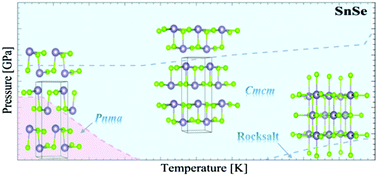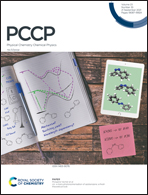Phase stability of the tin monochalcogenides SnS and SnSe: a quasi-harmonic lattice-dynamics study†
Abstract
The tin monochalcogenides SnS and SnSe adopt four different crystal structures, viz. orthorhombic Pnma and Cmcm and cubic rocksalt and π-cubic (P213) phases, each of which has optimal properties for a range of potential applications. This rich phase space makes it challenging to identify the conditions under which the different phases are obtained. We have performed first-principles quasi-harmonic lattice-dynamics calculations to assess the relative stabilities of the four phases of SnS and SnSe. We investigate dynamical stability through the presence or absence of imaginary modes in the phonon dispersion curves, and we compute Helmholtz and Gibbs free energies to evaluate the thermodynamic stability. We also consider applied pressures up to 15 GPa to obtain simulated temperature–pressure phase diagrams. Finally, the relationships between the orthorhombic crystal phases are investigated by explicitly mapping the potential-energy surfaces along the imaginary harmonic phonon modes in the Cmcm phase, and the relationships between the cubic phases are found by transition-state modelling using the climbing-image nudged elastic-band method.

- This article is part of the themed collection: 2021 PCCP HOT Articles


 Please wait while we load your content...
Please wait while we load your content...